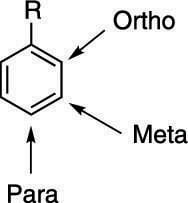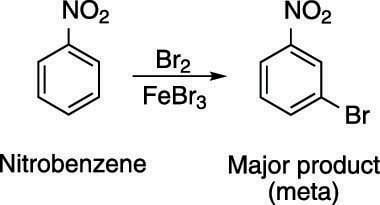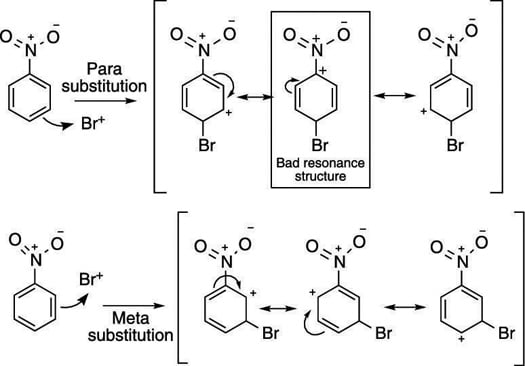When you synthesize disubstituted benzenes, and the first added group is an electron-withdrawing substituent, this group usually directs incoming electrophiles to the meta position (shown in the first figure).
The ortho, meta, and para positions
For example, take the bromination reaction of nitrobenzene, shown in the next figure. Nitro groups are electron-withdrawing groups, so bromine adds to the meta position.
The bromine substitution of nitrobenzene
To see why a meta product is formed instead of ortho-para products, compare the intermediate cation formed as a result of para bromine addition to the cation generated from meta addition (shown here).
The relative stabilities of intermediate carbocations resulting from para and meta substitution to nitrobenzene
The intermediate carbocation resulting from para substitution (or ortho substitution) has three resonance structures, but one of them is a particularly bad resonance structure because the structure has two adjacent positive charges (and like charges repel). Therefore, this bad resonance structure doesn't contribute much to the overall resonance hybrid. The cation resulting from meta substitution also has three resonance structures, but none of them is bad.So, for benzenes substituted with electron-withdrawing groups, the cation resulting from meta substitution is more stable than the cation resulting from either ortho or para substitution.
The main point to remember here is that electron-donating groups direct substitution to the ortho and para positions, while pi electron-withdrawing groups direct substitution to the meta position.
To clarify what is meant by electron-donating and electron-withdrawing substituents: Any substituent whose first atom (the one that's attached to the benzene ring) has a lone pair will be a pi electron donor to the phenyl ring, as shown in the resonance structure in the next figure.
Pi electron donors to the phenyl ring
Note that the resonance structures show that substituents that are pi donors add electron density to the ortho and para positions of the ring. So, pi donors activate the benzene ring toward electrophilic attack (attack by incoming electrophiles) at the ortho and para positions. Adding electron density to the benzene ring makes the ring more nucleophilic (that is, more nucleus loving) and activates the ring. Therefore, pi donors are considered ring activators.The only exceptions are the halogens, which are not terribly good pi donors. They deactivate the ring as a result of being highly electronegative groups, pulling electrons away from the benzene ring toward themselves, making the ring less nucleophilic. But even though halogens are ring deactivators, they're still ortho-para directors.
Pi-withdrawing groups (such as NO2 groups, carbonyl groups, CN, and so on) pull electrons away from the ring and deactivate it, making the ring less nucleophilic. Pi electron-withdrawers are thus ring deactivators. A deactivator means that the reaction of benzenes substituted with these substituents will be slower than the reaction of unsubstituted benzene. Pi electron-withdrawing substituents are meta directors. The table outlines the nature of different substituents.
The Nature of Aromatic Substituents
| Ortho-Para Directing |
Meta Directing |
| Strongly activating |
Weakly activating |
Deactivating |
Deactivating |
| OH |
Alkyl |
Halogens (F, Cl, Br, I) |
NO2 |
| OCH3 |
Phenyl |
— |
—COR (COOH, COOR, CHO, and so on) |
| NH2 |
— |
— |
CN |
| NR2 |
— |
— |
SO3H |





